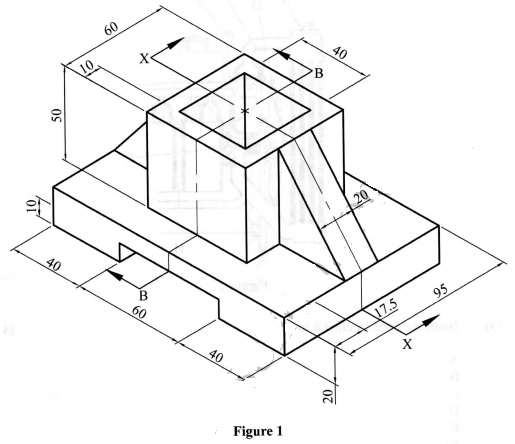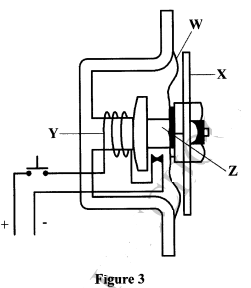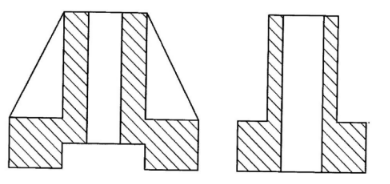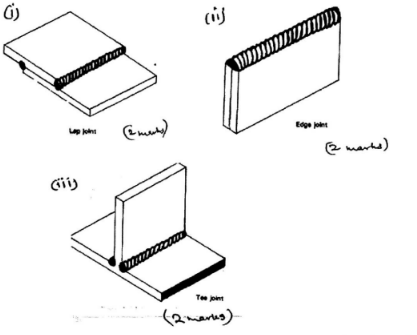SECTION A (40 marks)
Answer all the questions in this section in the spaces provided.
-
- Explain the meaning of integrity. (1 mark)
- Outline six characteristics that distinguish entrepreneurs from ordinary business people. (3 marks)
-
- State two safety precautions that should be observed when using electrical hand tools. (2 marks)
- John intends to construct a plain scale whose representative fraction is 1:5, to read a minimum of 10 mm and a maximum of 800 mm. Calculate the length of the scale. (2 marks)
-
- Identify four cleaning tools used in a power mechanics workshop. (2 marks)
- State the purpose of the following locking devices. (2 marks)
- Grub screw
- Palnut
-
- Explain the effect of adding the following alloys to steel. (2 marks)
- Tungsten
- Chromium
- Identify four areas in a motor vehicle where motors and generators are applied as energy convertors.
(2 marks)
- Explain the effect of adding the following alloys to steel. (2 marks)
-
- Explain the difference between an undersquare engine and an oversquare engine. (2 marks)
- List four causes of cylinder wall wear. (2 marks)
-
- List four components that must be disconnected from a multi-cylinder engine before it is disassembled.
(2 marks) - Identify four types of mechanical force transmitters used in motor vehicles. (2 marks)
- List four components that must be disconnected from a multi-cylinder engine before it is disassembled.
-
- Explain the importance of: (2 marks)
- Inlet valve lead.
- Exhaust valve lag.
- State two advantages of using water as a coolant in multi-cylinder engines. (2 marks)
- Explain the importance of: (2 marks)
-
- State two advantages of a tungsten halogen lamp over the conventional filament lamps. (2 marks)
-
- Define Castor Angle. (1 mark)
- State the importance of Castor Angle in steering. (1 mark)
-
- List two types of wheels used by heavy commercial vehicles. (1 mark)
-
- Explain the meaning of backfiring during oxy-acetylene welding. (1 mark)
- State two causes of backfiring during oxy-acetylene welding. (2 marks)
-
- State two desirable characteristics of an effective brake drum. (2 marks)
- Identify two forces that acts on a leaf spring due to the action of the driving axles. (2 marks)
SECTION B (60 marks)
Answer question 11 on A3 paper and any other THREE questions from this section in the spaces provided. Candidates are advised to spend not more than 25 minutes on question 11.
- Figure 1 shows a block drawn in isometric projection.
Draw full size in third angle projection the following veiws:- sectional front elevation along the cutting plane X-X
- sectional end elevation along the cutting plane B-B
- Figure 2 shows a typical pressurised water cooling system.
- Name the parts labelled A to H. (4 marks)
- Explain how the system works. (11 marks)
-
- Outline three factors that are used to determine the type of an internal combustion engine. (3 marks)
- Explain six operational differences between 2-stroke and 4-stroke cycle petrol engines. (12 marks)
-
- Name five types of non-fusion welding rods and in each case, identify one material that are used to weld in motor vehicles. (5 marks)
- With the aid of diagrams illustrate the following types of soldered joints. (6 marks)
- lap
- edge
- tee
- Explain two difficulties experienced when welding cast iron. (4 marks)
-
- Identify four possible causes of each of the following engine problems. (8 marks)
- Engine stalls after idling or slow speed driving.
- Engine backfires
- Figure 3 shows the horn circuit.
- Name the parts labelled W, X, Y and Z (2 marks)
- Explain how the circuit operates. (5 marks)
- Identify four possible causes of each of the following engine problems. (8 marks)

MARKING SCHEME
-
- Integrity - steadfast adherence to a strict moral or ethical code or pureness or uprightness (1 mark)
-
- Very aggressive
- Take calculated risks
- Adventurous
- Persistent
- Future focus
- Action oriented
- Working extra harder
- Optimistic
- High profit orientation
- High drive for achievement e.t.c.
(Any 6x½mark) (3 marks)
-
-
- Ensure the plug is properly and safely connected to the tool.
- Ensure all wires are insulated.
- Never use electrical tools when standing on a damp floor.
- Ensure the tools are properly earthed.
- Never use tools with naked and loose wire joints.
(Any 2 x 1 mark) (2 marks)
- Scale length = Representative fraction x Maximum reading (1 mark)
= 1/5 x 800 = 160mm 1/5 x 800 = 160mm (1 mark)
-
-
- Cleaning tools
- Wire brush
- Power wire wheel
- Buffing wheel
- Bristle brush
- Scraper
- Sanding block
(Any 4 x mark) (2 marks)
-
- Grub screw
- Often used with keys to prevent a pulley from moving along a shaft. (1 mark)
- Pal nut
- Is a single threaded nut used lock another nut to prevent it from working loose (1 mark)
- Grub screw
- Cleaning tools
-
-
- Tungsten -increases hardness (1 mark)
- Chromium-increases strength and hardness (1 mark)
-
- Starting system - (Starter motor)
- Wipers - (Motor)
- Charging system - (Alternator)
- Odometer - (Generator)
- Gauges e.g.
- Tachometer - (Ac generator)
(Any 4x½mark)
-
-
-
- Undersquare engine (1 mark)
Is one where the bore is smaller than the stroke. Therefore the piston travels longer distance per minute to cover a stroke, and thus travels at a higher speed to cover a given RPM. - Oversquare engine (1 mark)
Is one where the bore is larger than the stroke. Therefore, the piston travels a shorter distance per minute to cover a stroke, and thus travels at a lower speed to cover a given RPM.
- Undersquare engine (1 mark)
- Causes of cylinder wall wear (2 marks)
- The piston, especially the thrust side.
- Piston rings.
- Abrasive material from lubricating oil.
- Poor quality oil
- Engine overheating
(Any 4x½mark)
-
-
-
- Battery
- Radiator
- Air cleaner
- Start motor
- Bell housing
(Any 4x ½mark) (2 marks)
-
- Levers and cables
- Belts and pulleys
- Wheels and pulleys
- Chairs and sprockets
- Gears
- Clutches
(Any 4 x½ mark) (2 marks)
-
-
-
- Inlet valve lead (1 mark)
This early-opening gives as long as possible time for the intake of fresh (1 mark) charge into the cylinder. - Exhaust valve lag (1 mark)
Gives adequate time for the exhaust gases to be cleared from the cylinder. (1 mark)
- Inlet valve lead (1 mark)
-
- It has a high specific heat capacity
- It is readily available
- It is not costly
- Absorbs mechanical noise
(Any 2 x 1 mark)
-
-
-
- The filament do not burn easily because of chemical interaction with the gas.
- It operates at higher temperature without blackening.
- It emits more brightness
(Any 2 x 1 mark)
-
- Castor angle
Is the tilt of the spindle pivot towards the front or the rear of the vehicle from the vertical axis. - It plays an important role in self-centering of the wheels after cornering.
- Castor angle
-
-
-
- Flat base - two piece rim.
- Flat base divided rim.
- Flat base-three piece rim.
- Semi-drop center rim
(Any 2 x mark)
-
- Backfiring during welding procedures refers to when the flame goes out, producing a loud snapping or popping noise at the nozzle.
- Causes of backfiring include:
- If the torch touched the hot metal
- If there is a piece of hot metal blocking the nozzle orifice
- When the torch tip is loose
- When the torch nozzle is overheated.
(Any 2 x 1 mark)
-
-
-
- Should be light in weight
- Should have adequate strength
- Should be able to rapidly absorb and dissipate heat
(Any 2 x 1 mark)
-
- Twisting or tension when one wheel is deflected
- Bending due to the load and weight of the vehicle
- Driving and braking thrust transferring the axle motion to the chassis
- The driving and braking torques reaction forces due to the resistance of the axle to rotate.
- (Any 2 x 1 mark)
-
-
M.S.
3rd Angle projection =1
F.E: 5 faces 5x1 = 5
Sectioning 2x1 = 2
EE: 4 faces 4x1=4
Sectioning 2x1=2
Neatness =1
Total = 15 marks -
A- Radiator
B- Filler cap
C- Water pump/cylinder wall
D-Fan
E-Thermostat
F-Temperature gauge
G-Upper water gallery
H-Water jacket
(Any 8 x ½ mark = 4 marks- Operation (11 marks)
When the car starts, the engine is cold and the thermostat shuts off the flow of water to the radiator). Since the water is confined to flow within the engine, it heats quickly as the engine runs hot. When water reaches a pre-determined temperature, the thermostat opens, allowing free flow of coolant. The hot water leaves the engine through the upper hose to the radiator. In the radiator, it passes through the radiator core tubes, which are surrounded by cooling fins," through which air is drawn inwards by the low pressure vacuum created by the revolving fan. This air cools the hot water as it passes down the radiator core. The cooled water is then drawn into the engine by the water pump through the radiator return pipell into the water jackets surrounding the cylinders to cool the engine block When there is excessive pressure build up in the system, the radiator cup equalizes the internal system pressure with the atmospheric pressure.
-
-
- Number of cylinders e.g. 1,2,4,6,8,12 e.t.c.
- Arrangement of the valves e.g. 1, L, F, T and H.
- Arrangement of the cylinder e.g. Inline vertical, Inline horizontal, Inclined inline, radial, V-arrangement, horizontal opposed.
- Type of fuel e.g. petrol (gasoline), diesel, ethanol, industrial alcohol e.t.c.
- Type of cooling system e.g. air-cooled, coolant or water cooled e.t.c.
- Type of cycle e.g. two strokes cycle or four stroke cycle
(Any 3 x 1 mark)
- Operational differences between 2-stroke and 4 stroke cycle engines
(12 marks)2 Stroke 4 Stroke -Piston performs two tasks
(a)Acts as a valve
(b)Is the compressor in primary and secondary compression-Mixture comprises of petrol, air and lubricating oil.
-Engine has two compressions Primary compression which takes place in the crank case and secondary compression
which takes place in the cylinder head.
-For every revolution of the crankshaft (ie. 360°), the engine has a power stroke
-Not all exhaust gases are cleared out of the combustion chamber, hence this prevents a huge amount of fresh charge from entering the cylinder.
-Has smoother running because it has only
one dead stroke per cycle
-Runs at higher temperatures and is difficult to time because strokes are too short.
-Engine records higher fuel consumption
because of high scavenging (Explain any 6 x 2 marks)-Piston only acts as the compressor since the engine has valves
-Mixture comprises of fuel and air only.
-Engine has only one compression which takes place in combustion chamber
-For every 2 revolutions of the crankshaft (i.e. 720°), the engine has a power stroke.
-Nearly all burnt gases are cleared from combustion chamber allowing more fresh charge to enter.
-Has rough running because it has three dead strokes per cycle.
-Runs at lower temperatures, and is easier to time.
-Engine is more economical in fuel consumption because there is little scavenging
-
-
- Non fusion welding rod Where used to weld
- Nickel bronze rods Used on steel and malleable irons
- Silicon bronze rods On brass, copper tubes, GI sheets
- Manganese bronze rods Cast iron and building gear teeth
- White brazing rods Steel and Nickel
- Silver soldering rods Used for low and high melting points copper, brass and steel
(Any 5x½mark)= 2½ marks (Any 5x½mark)=2½ marks
-
- Difficulties in welding cast iron
- Cast iron never attains fluidity the same way as steel; penetration is more difficult and promotes oxidation in the weld. For this reason, a flux is necessary when welding cast iron.
- Cast iron is a brittle material. The uneven expansion and contraction caused by local heating often makes it to crack. This fault is due to the fact that most cast irons are normally in cast forms.
- Non fusion welding rod Where used to weld
-
-
- Engine stalls after idling or slow speed driving
- Defective fuel pump
- Overheating
- High carburetor float level
- Idling adjustment incorrect
- Malfunction PCV valve
(Any 4x 1 mark)
- Engine backfires
- Idle stop or solenoid adjustment not correct
- Engine overheating
- Hotspots in cylinders due to carbon
- Excessively lean or rich mixture
- Cracked distributor cap
- Valves hot or sticking
(Any 4 x 1 mark)
- Engine stalls after idling or slow speed driving
-
(2 marks)
- Operation of the horn circuit. When the push button is pressed, current flows through the contact points to the electromagnetic coil. The coil gets energized and attracts the armature, which moves together with the diaphragm which is attached to it. When the armature is attracted, the contact points open, breaking the flow of current. The coil is the de-energized, thus making armature to be released. And to move back closing the points to start the procedure again.
-
Download KCSE 2017 Power Mechanics Paper 1 with Marking scheme.
Tap Here to Download for 50/-
Get on WhatsApp for 50/-
Why download?
- ✔ To read offline at any time.
- ✔ To Print at your convenience
- ✔ Share Easily with Friends / Students






